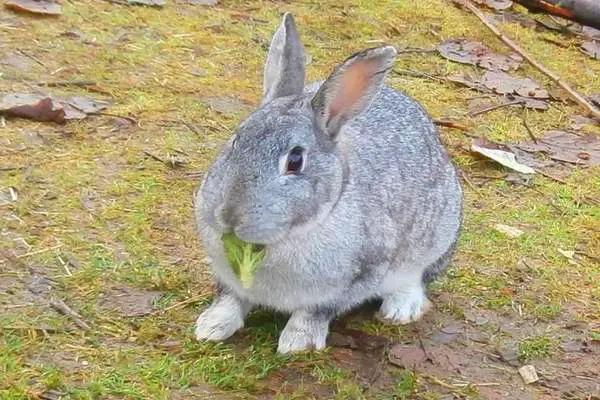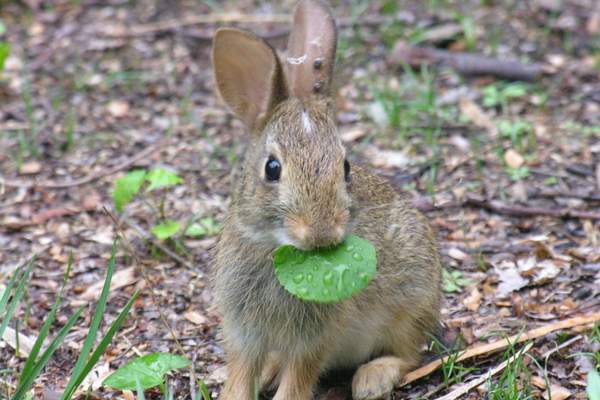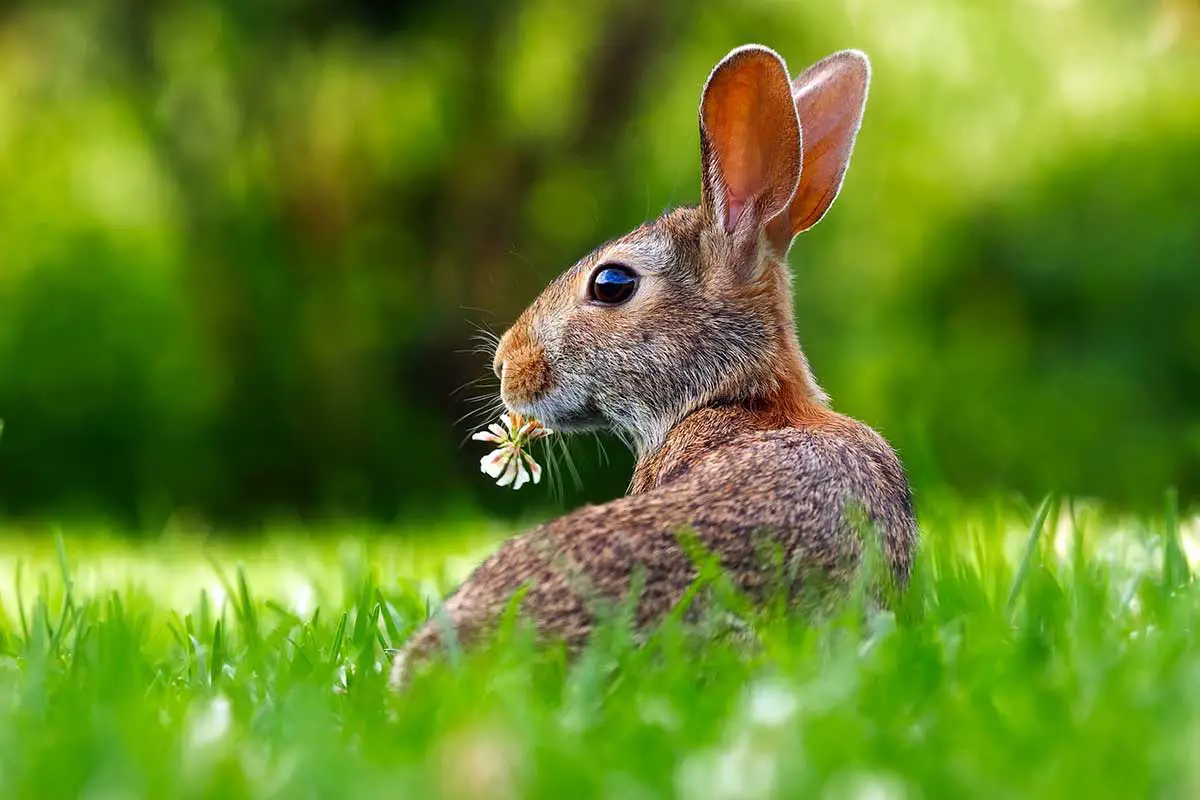Rabbits are complex creatures that bring us as much joy and entertainment as they bring confusion. Some of their behaviors can be downright puzzling—like running around with food in their mouths. This behavior most likely is no cause for worry.
So, why does my rabbit run around with food in his mouth? The most likely reason is that your bunny is being territorial. There are a few other things that could be going on, all of which are normal and most likely no cause for concern.
In this article we will examine a rabbit’s natural inclination toward territorial behavior, rabbit hierarchy and dominance behavior, prey animal instincts, feelings of food insecurity, and simple play behaviors.
Territorial Behavior

Many people are surprised to learn that rabbits in the wild are highly territorial animals. Wild rabbits live in large family groups and although they are quite social, they also value their own space highly and go to great lengths to mark and protect those spaces.
Another surprise to most people is that rabbits have not been domesticated for long, which means the wild instincts that domestic rabbits have are still quite strong and are often displayed in the home regardless of how docile they seem with their human companions.
If your rabbit takes treats, hay, or other food items from you and immediately runs off with them to another location to eat or store, they may view you or another pet in the home as a rival with which they must establish territorial “rules.”
This is not necessarily a bad thing and by no means does it indicate that your rabbit dislikes you, they are simply being driven by their instincts. In a multi-rabbit home, the likelihood of this behavior being driven by territoriality is even higher. When driven by territoriality, this behavior could be a “power play” by your rabbit to exert dominance.
Your rabbit might also simply be communicating to you or other rabbits in the home that this food is theirs and no one can have it! If your rabbit is displaying this behavior with only you, spend more time grooming and petting them to help them see that you are not a rival.
If this behavior is being displayed with other rabbits in the home, allow them to work it out for themselves provided they are not fighting, as they need to establish their places in your home’s hierarchy.
Wild and domestic rabbits tend to live within a hierarchical structure which impacts their territorial behavior and many other behaviors, which could be compelling your rabbit to run around with food in its mouth.
Hierarchy and Dominance Behavior

In the wild, rabbits exist in social hierarchies consisting of multiple family groups, usually with a dominant female and male pair, with subordinate family groups beneath them. This structure ensures the efficiency and safety of the group, and like many other behaviors, is an instinct that domestic rabbits inherited from their wild predecessors.
As part of hierarchical behavior, many rabbits exhibit dominant characteristics. In the wild, rabbits will often challenge each other for better places within their hierarchy, and domestic rabbits who live in groups are no different.
In domestic pairs or groups, there is usually always one dominant rabbit or pair of rabbits. If this structure is not yet established in your home, expect some showboating and head butting (but not literally) between your furry friends.
If your rabbit recently began exhibiting this behavior after introducing new pets to the area, or you suspect your pal might be dissatisfied with its place on the social ladder, look for some of these additional dominance behaviors:
- Mounting (both males and females)
- Chasing or circling
- Nipping and biting
- Barbering (aggressive grooming resulting in pain or injury)
- Hoarding of food or toys
- Demands for grooming (head down toward other rabbits)
These behaviors can indicate that a rabbit is either the dominant rabbit or seeking to challenge the dominant rabbit in your home to take its place. Taking food from a communal area or from a specific rabbit’s bowl/rack may be a power play that is part of a collection of dominance behaviors.
Again, these behaviors are not necessarily bad; rather, they are normal and natural and should be allowed, provided your furry friends are not hurting each other. If you do not suspect territoriality or dominance behaviors are driving your rabbit to run around with a mouthful of food, consider its instincts as a prey animal.
Prey Animal Instinct and Food Insecurity
Rabbits are inherently different from their domestic counterparts like dogs and cats in many ways, the primary difference being that while dogs and cats are predatory, rabbits are prey animals. Part of the reason rabbits in the wild live in large groups is for safety against predators.
Rabbits also rely on their sharp senses, speed, and agility to keep them safe. As prey animals, rabbits in the wild tend to hide any illness, injury, or other perceived weaknesses to make them less appealing to predators, which includes eating. When a rabbit is eating its other senses are still operational, but its focus is largely on food, so it is left vulnerable.
Again, as with other inherited behaviors, this instinct is not lost on domestic rabbits. If your furry friend feels at all vulnerable in your home, whether that be because it is in a new environment or there are other/new pets in the home, it may exhibit “on-guard” behavior while eating which could include taking food and moving it to what it perceives as a safer location.
If you suspect your rabbit feels unsafe or vulnerable in your home, ensure they have a place or places to hide where they feel secure, and spend plenty of time grooming and petting them to let them know they are safe.
In addition to prey animal instincts, your rabbit may be experiencing feelings of food insecurity. Unlike many of the other behaviors we have discussed here, this specific feeling is not driven by wild instinct. Rabbits in the wild graze over large areas constantly throughout the day, and even in large groups rarely must compete for food sources.
Domestic rabbits, on the other hand, may begin to experience feelings of food insecurity if their feeding routine is unpredictable or disrupted. While you know there will never come a time that your cotton-tailed companion will be wanting for food, they may develop feelings to the contrary.
If your rabbit seems to be comfortable with its space and its place in your home’s hierarchy, it may be taking food to store for later if it feels food scarcity is an issue. This is not automatically a bad thing but could lead to more stress or anxiety for your bunny, so to the extent possible, make sure to keep your bunny on a consistent feeding schedule.
If your rabbit is comfortable with your home’s hierarchy and does not seem to be displaying prey animal or food insecurity behaviors, it may be nesting.
Nesting Behavior

Contrary to popular belief, nesting behavior can take place with both male and female rabbits, but is far more common with non-spayed females. Nesting behavior in rabbits is usually exhibited by taking mouthfuls of hay, straw, or other grasses, as well as clumps of the rabbit’s own fur, to create a cozy nest for offspring.
This is one of the main ways you can tell if your female rabbit is expecting, however, rabbits do experience false pregnancy on a somewhat frequent basis. It is important to recognize as soon as possible if you might be dealing with a rabbit pregnancy, so be on the lookout for some of these other signs and symptoms:
- Weight gain (usually minimal)
- Increased appetite
- Showing (belly growing disproportionately to the rest of the rabbit’s body)
- Uncharacteristic moodiness
- Small, marble-sized lumps in rabbit’s belly (it is important to be gentle when feeling for kits; the best way to do this is to have your veterinarian examine your rabbit)
If your rabbit is taking hay or other items away from their eating area and exhibiting some or all these other symptoms, schedule a visit with your veterinarian to determine if your furry friend is expecting a few bundles of joy.
If none of these things seem to fit your situation, you rabbit may simply be acting playful or is excited about the food you just gave.
Play Behavior
If your bunny is happy and healthy, spayed/neutered, or otherwise not pregnant, and at ease with the hierarchy in your home, they may be taking mouthfuls of food or other items because they like to play with it! There are just about as many rabbit personalities as there are rabbits, and each one exhibits their unique quirks in different ways.
Many rabbits love running around as fast as possible to show their joy or elation, and this may include having a mouthful of food just for the fun of it.
Further, your rabbit might be extra excited about the kind of food you just gave and may be running around with it to celebrate and tell you they appreciate your efforts. In either case, this behavior is not harmful and should be enjoyed by all.
Conclusion
If your rabbit is taking mouthfuls of food and running around with it, especially in a multi-rabbit household, it likely is exhibiting territorial behavior. Your rabbit may also be displaying dominance behavior in relation to your home’s hierarchy. This behavior is normal and is no indication of your rabbit’s feelings toward you.
It should be allowed to run its course provided your rabbits are not hurting each other. Your furry friend may also be exhibiting prey animal instincts or feelings of food insecurity, both of which can be mitigated with consistent routines and interaction to put your pal at ease.
Further, your rabbit could be demonstrating nesting behavior, and a vet visit should be scheduled to rule out pregnancy. Finally, your pal might simply be playing out of joy or excitement for the delicious treat you just gave.
In any case, this behavior typically is no cause for concern provided you are ensuring a safe, happy environment for your cotton-tailed companion.

